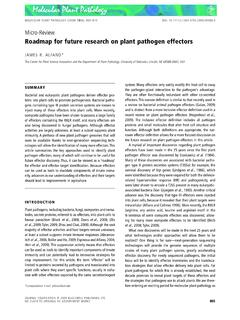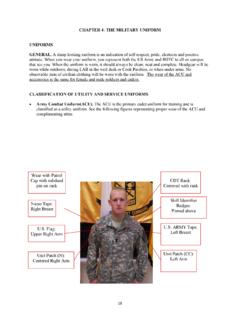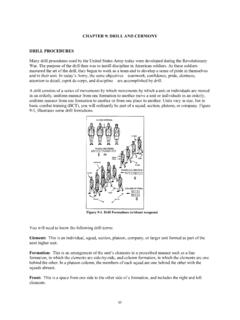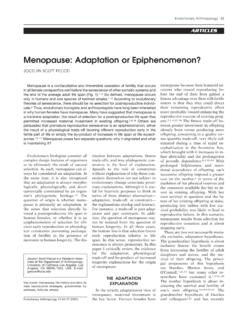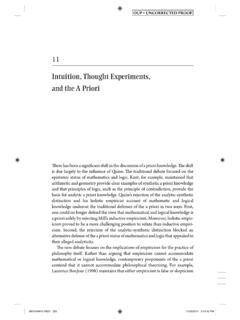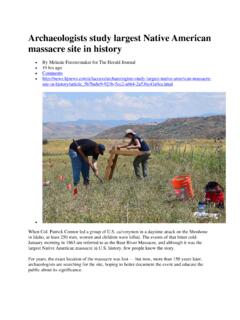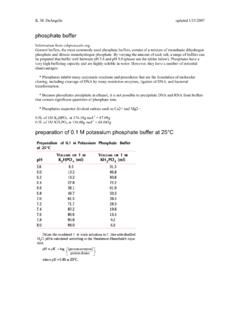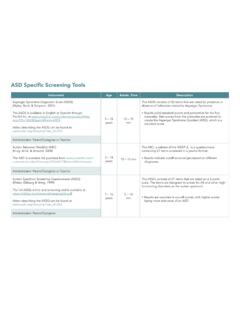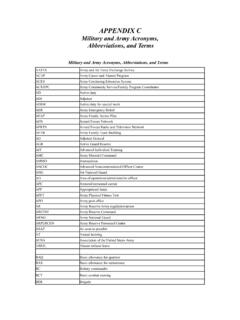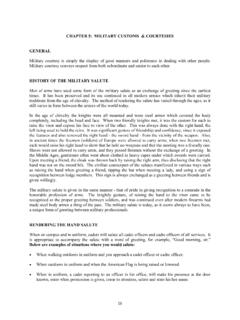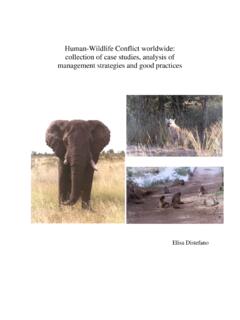Transcription of Chapter 1: Research Objectives and Methods
1 Sustaining Agriculture in Urbanizing Counties: Insights from 15 Coordinated Case Studies (a study funded through a grant from the National Research Initiative of USDA s Cooperative State Research , Education, and Extension Service: Grant #2004-35401-14944) Chapter 1: Research Objectives and Methods1 1. Introduction: Time Context The credit crisis that seriously discouraged housing and other developments on agricultural land began in 2007, by some people s calculations in August of that year. Under a grant provided by the National Research Initiative Program of USDA s Cooperative State Research , Education, and Extension Service in the fall of 2004, we studied the conditions shaping the viability of farming in 15 metro-area counties in 14 states. Each selected county was both agriculturally still important and then subject to substantial development pressures. The majority of our Research efforts took place in 2005 through mid-2007, when those pressures were high or just beginning to diminish.
2 Also during most of that period, market prices were mediocre for grains, milk, and certain other types of major products raised in the studied counties. Therefore, since we studied the viability of urban-edge farming under difficult conditions, many of the successes we found are models of achievements against considerable odds. If they worked in 2005 to 2007, they may be feasible in future challenging situations. At the least, the positive and negative outcomes we identified in those years may serve as bases of comparison for viability evaluations conducted in the same or similar counties in later years. Adding to the future relevance of our findings, we believe, is our emphasis on causal relationships. We used regression analysis of survey findings and thematic analysis of interview data to get at the conditions that shaped agriculture s viability in our sample of urbanizing metro-area counties. For example, rather than only reporting that zoning worked well in protecting agricultural land in this or that county, we used in-depth interviews with local experts to discover explanations for such success.
3 And, rather than just offering the percentages of agland owners, by county, who planned to develop their land, we used statistical analysis to identify traits of the owners and their farm operations that, other things being equal, predicted who expected to convert land out of agricultural use. In another two examples, we studied (1) why so many farmers in the sampled counties were able to rely heavily on foreign migrant laborers and (2) how farm operators adapted to the closure of local implement dealers and other agri-service businesses. 2. Motivation for the Research Beginning at least with Donald Bogue s study The Spread of Cities (1956), researchers concerned about the survival of agriculture on the urban edge tended to emphasize the loss of agricultural land and/or policy efforts to prevent it ( , Coughlin, Keene, Esseks, Toner, and Rosenberger, 1981). In 1982 Roger Blobaum pointed out that efforts to preserve agricultural land on the urban fringe put little emphasis on making farms more profitable (Blobaum, 1982).
4 Five years later, Johnston and Bryant (1987) asked the important question of why there were still 1 The principal authors of this Chapter were Dick Esseks and Kate Clancy. so many farms in urban areas across the United States and Canada, and proposed that it was due to the positive adaptation that farmers had exercised to suit prevailing conditions, demonstrating that many farms could remain viable despite strong development pressure. The authors argued that farmers did this by exploiting opportunities characteristic of rural urban fringe environments (p. 10). In the past decade there has been more attention paid to the need to simultaneously improve the markets and incomes of farms on the urban edge because, among other reasons, so much food is produced there. Using 1997 Census of Agriculture data, the American Farmland Trust calculated that 86% of all the country s fruits and nuts, 86% also of its vegetables production, and 63% of dairy products were produced in urban-influenced counties (American Farmland Trust, 2003).
5 The Economic Research Service (ERS), also working from 1997 ag census data, estimated that 61% of vegetable acres were in metro areas (Heimlich and Anderson, 2001). From the 2002 census, Douglas Jackson-Smith and Jeff Sharp (2008) calculated that 55 percent of all farm sales in the United States were from farms located at the rural-urban interface (p. 1). However, even recently, authors of this Research report have found it difficult to convince some advocates of farmland protection and smart growth that preventing the conversion of agland is not enough. To realize the full agricultural benefits of restrictive zoning, purchase of development rights, or urban growth boundaries depends on whether farmland remains in an active agriculture use (Nickerson, 2001, p. 27). The alternatives can include farmettes that have just enough production to qualify for agricultural-use tax assessment or larger parcels that seriously underperform for lack of good markets or effective management.
6 Researchers have compiled a long list of the potential benefits to farmers and urban dwellers of the presence of farms near metropolitan areas. Farmers may be able to access a larger pool of seasonal labor to harvest high-value crops; there should be greater off-farm employment opportunities; and there are probably opportunities for marketing to urban populations, such as restaurants and farmers markets, and for products new to the farmer such as nursery plants and Christmas trees, as well as agritourism (see, for example, Maryland-National Capital Park and Planning Commission, 2005). There tends also to be a greater variety of socioeconomic production types such as part-time farmers and more family members working off the farm. Among other things is a greater diversity of financing mechanisms (including for leasing land) and a larger variety of production intensities (especially with regard to fruits and vegetables; Bryant and Johnston, 1992).
7 A dictionary definition of viability is capable of working, functioning, or developing adequately ; and a more specific one for business enterprises is the state of being financially sustainable (Merriam-Webster, 2006). Farm viability has been defined as (1) a state where a farm may continue to operate, expand, and meet the goals of the farm owner (Heinrich-Schiller Joint Venture, 2004, p. 210), and (2) as a quality that includes longevity, respect, a positive working environment, encouragement to innovate, and a belief in an agricultural future (Somerset County, 2001, in Heinrich-Schiller Joint Venture, 2004, p. 211). The continuation of viable farming near or in metropolitan areas may require effective farmland preservation programs: , restrictive zoning, cluster zoning, urban growth boundaries, purchase of development rights, and/or transfer of development rights topics covered in Chapter 3 of this 1- 2 report. Also needed may be programs designed to keep preserved land in active agricultural use, such as encouraging consumers to purchase locally grown food, educating farmers about diversifying or switching into value-added or other new products, providing financing for beginning farmers, recruiting sufficient migrant workers, and helping with the intergenerational transfer of management and ownership topics discussed in Chapters 2 and 4 of this report.
8 3. Research Objectives As stated in our application for the National Research Initiative Grant that made this study possible, our main objective has been to identify conditions under which farming may remain viable as important agricultural counties transition to become mostly urban and suburban in land use. Given this principal objective, we selected 15 such areas to study and pursued the subsidiary Objectives of determining the kinds of agricultural products that were being successfully raised there (discussed in Chapter 2); the adequacy of marketing outlets for crops and livestock products (also discussed in Chapter 2); the supply and affordability of land for farming and ranching ( Chapter 3); the adequacy of other major inputs of production hand labor, new farmers, veterinarians, credit, and agriservice businesses that supply equipment, repair services, chemicals, water, etc. ( Chapter 4); and the future outlook for agriculture, including agland owners plans for converting any of their land to nonfarm uses, current operators expectations about continuing to farm there, both surveyed agland owners and interviewed local leaders predictions about the status of agriculture in their counties in the future , and whether the leaders would encourage young people with agricultural backgrounds to farm or ranch there ( Chapter 5).
9 For each of the major kinds of marketing outlets and inputs of production, we inquired about the existence and effectiveness of government or private programs to help with the quantity or quality of supply. We aimed to report on the degree of success (and causes of the observed effectiveness) of such programs as preserving farmland, promoting the direct marketing of locally grown food, recruiting seasonal workers, linking new farmers with retiring operators, and protecting water supplies needed for agriculture. 4. Justification for Our Research Focus Before asking the reader to wade into our discussion of Research Methods , we must first justify the choice of Research focus. Is protecting farmland and otherwise nurturing viable agriculture on the urban edge an important enough goal for local communities or the country as a whole? As mentioned earlier, the counties in metro areas or otherwise subject to urban influence have been producing most of the nation s fruits, nuts, vegetables, and dairy goods.
10 However, scholars like John Fraser Hart (2002) argue that the same types of products can be grown more efficiently outside urbanizing areas, as farmers (or their successors) sell their urban-edge land and reinvest the capital gains in better-sized and -equipped farms one or more counties away from metro areas. On the other hand, farmers markets are proliferating in urban and suburban areas. A USDA survey counted 4,385 farmers markets operating in 2006, a 150% increase over 1994 (Brown, 2001). Although many vendor-growers from nonmetro-area farms can successfully 1- 3 transport their produce to those markets, local producers have the advantage of inviting customers to visit their farms to see where and how food is produced and if they (the consumers) are inclined to pick what they buy and take it home to eat. Proximity to urban or suburban customers is also an advantage to other farms that sell directly to customers. The latter may visit on-farm stores and stands or temporary tailgate points of sale alongside roads in towns.
